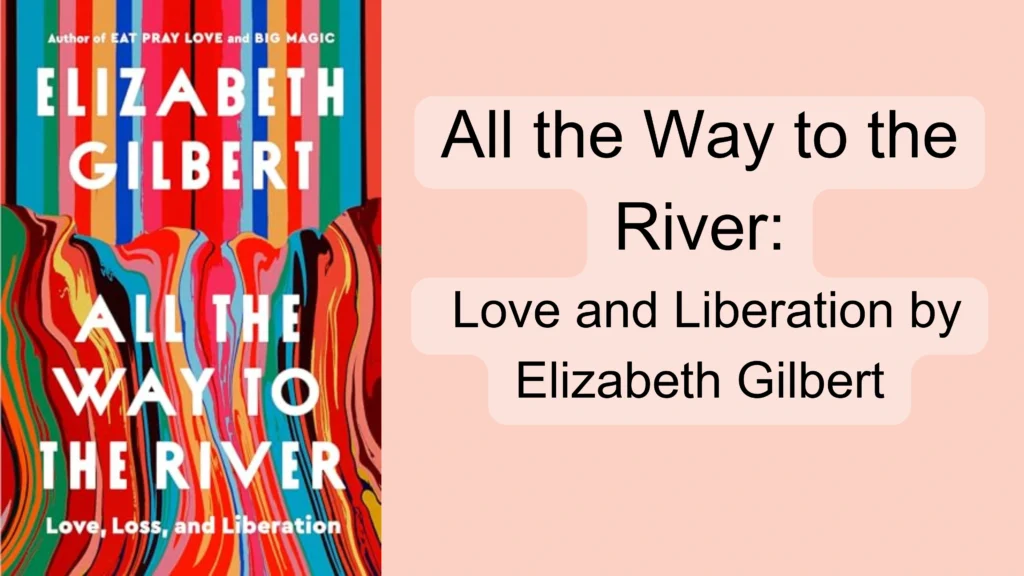All the Way to the River: Love and Liberation by Elizabeth Gilbert
In what may be her most vulnerable and spiritually profound work, Elizabeth Gilbert takes readers on an intimate journey through grief, love, and the discovery that death is not the ending we’ve been taught to believe. All the Way to the River chronicles Gilbert’s relationship with her beloved partner Rayya Elias through terminal illness and beyond, offering a raw and tender account of what it means to love someone “all the way to the river” – and to discover that love continues on the other side.
This isn’t the lively, adventurous Elizabeth Gilbert of Eat, Pray, Love. This is a woman brought to her knees by loss, compelled to face the fundamental questions about consciousness, death, and whether the bonds we forge in life can endure beyond the dissolution of the body. What she uncovers – and bravely shares – is that her relationship with Rayya didn’t end at death but evolved into something both more mysterious and more certain.
SIGN UP TO MAILING LIST
The Continuing Conversation
Gilbert writes with characteristic honesty about her ongoing relationship with Rayya after her physical death. These aren’t vague feelings of presence or wishful thinking – Gilbert describes specific communications and signs that contain information she couldn’t have known, as well as a persistent sense of Rayya’s personality, humour, and love that feels as real as it did when Rayya was alive.
What makes Gilbert’s testimony so convincing is her practicality. She’s not someone inclined towards mysticism or magical thinking. She’s a writer who values precise observation and truthful reporting. When she describes finding feathers in unlikely places at significant moments, hearing songs that answer questions she’s just posed, or feeling Rayya’s presence so vividly that she speaks to her aloud, we trust that she’s conveying her experience as truthfully as possible.
Gilbert doesn’t try to convince sceptics or prove anything scientifically. She reports what she’s experiencing with the same journalistic clarity she brings to all her writing. The effect is more powerful than any argument could be – we believe her because she’s clearly not trying to convince us of anything except that this is genuinely what she’s experiencing.
Love as the Bridge
At the heart of All the Way to the River is a profound insight about the nature of love and death. Gilbert suggests that love isn’t just an emotion we feel during life – it’s a connection that transcends physical form. The depth of love she shared with Rayya created a bond that death could shift but not sever. She describes death not as a wall but as a river – Rayya crossed to the other side, but Gilbert can still reach her across the water, and sometimes Rayya reaches back.
This metaphor of the river is both powerful and comforting. Death isn’t a final separation but a transformation similar to a connection. Those we love move to a different shore, but the river can be crossed—not physically, but through consciousness, dreams, signs, and the persistent feeling that love does not obey the same laws as matter.
The Transformation of Grief
Gilbert is refreshingly honest about the reality of grief – it’s excruciating, it doesn’t follow a timeline, and it doesn’t “get better” in the ways people promise it will. But she also describes how the continuing sense of connection with Rayya has transformed her grief. She still misses Rayya’s physical presence terribly, but she no longer feels that the relationship is lost. It’s changed, but it continues.
This perspective offers hope to anyone experiencing the loss of a loved one. Gilbert isn’t suggesting that recognising ongoing connection removes grief—she’s suggesting it can exist alongside grief in ways that make the loss more manageable. You can miss someone’s physical presence while still feeling their spiritual presence. You can grieve what you’ve lost while being thankful for what continues.
SIGN UP TO MAILING LIST
Permission to Believe
Perhaps the most valuable gift Gilbert offers readers is permission to trust their own experiences of connection with deceased loved ones. Many people have these experiences – the sense of a loved one’s presence, meaningful signs and synchronicities, and dreams that feel like actual visits – but dismiss them as wishful thinking or fear sharing them because of how others might react.
Gilbert’s willingness to speak openly about her continuing relationship with Rayya normalises these experiences. She makes it okay to believe what you’re experiencing, to trust the signs you’re receiving, to maintain a relationship with someone who has died without feeling like you’re being pathological or refusing to “move on.”
A New Understanding of the Afterlife
The vision of the afterlife presented in Gilbert’s book is warm, intimate, and deeply relational. Death doesn’t transport souls to some distant heaven—it shifts them into a different form of existence that’s still intimately connected with the living. The deceased remain interested in and aware of their loved ones’ lives. They can communicate, offer guidance, and express continued love.
This isn’t the afterlife of religious dogma or New Age fantasy. It’s described in Gilbert’s characteristic voice – practical, grounded, and focused on lived experience rather than ideology. Rayya isn’t floating on clouds playing a harp. She’s still Rayya – funny, irreverent, deeply loving – just in a different form that Gilbert is learning to recognise and communicate with.
Rating: ★★★★★
A profoundly moving and spiritually transformative work that offers both comfort to the grieving and evidence that love truly does transcend death. Essential reading for anyone navigating loss or wondering about the nature of consciousness and the afterlife.
Get your copy here

